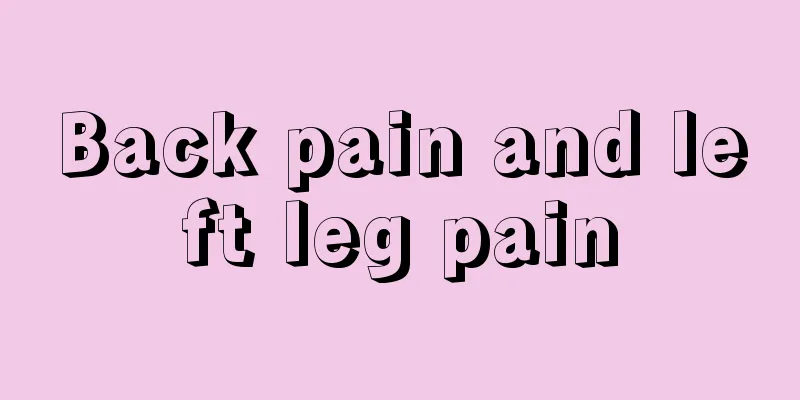Back pain and left leg pain

|
Weakness and pain in the body will have a great impact on the patient's physical and mental health, and even affect the patient's daily life. Lower back pain accompanied by buttock pain is a common symptom. This symptom is generally caused by lumbar muscle strain. If this problem occurs, you must go to the hospital for examination in time. In addition, some specific exercise methods can also be used to relieve the symptoms of lumbar muscle strain. 1. Consider lumbar muscle strain Lumbar muscle strain is one of the common causes of low back pain. The main symptoms are swelling and soreness in the waist or lumbosacral area, which recur repeatedly. The pain may vary with climate change or degree of fatigue. The lower limb symptoms caused by lumbar spine problems are mostly below the knee joint, with pain or (and) numbness. This is one of the more common symptoms of low back pain and leg pain. II. Comments and Suggestions If you experience lower back pain accompanied by leg pain and numbness, you should go to the hospital for CT and MPI examinations, and also combine it with a doctor's clinical examination. 3. Exercises to relieve back pain and leg pain 1. Lie flat on the bed, bend your knees and place your feet on the bed, then lift your hips up about 10 cm off the bed. You will feel your back muscles exerting force. Hold for about 3-5 seconds and then put it down. Repeat this 10 times. Do this method 3 times a day. 2. Lie face down on the bed with your upper limbs straight on both sides of your body. Lift your upper body about 10 cm. You will feel your back muscles exerting force. Hold on for 3-5 seconds and then put it down. Repeat this 10 times. Do this 3 times a day. 3. Abdominal muscle exercise: do sit-ups, 10 times each time, 3 times a day. 4. Stand and twist your hips with your feet shoulder-width apart, your hands on your hips, and twist your hips to the left and right while your shoulders slightly tilt backwards. Do this 100 times in total. 5. Bend forward and stretch backward, with your arms and legs spread as wide as shoulders, toes pointed inward, and slowly bend forward so that your hands gradually touch the ground. Then stretch your waist backward as far as possible, and repeat 10 times. 6. Cross waist twist: Place your feet shoulder-width apart, toes pointed inward, arms straight, one hand at the side of the body, and one hand raised over the head. If the left hand is on top, swing it to the right rear first, then the right hand is on top and swing it to the left rear. Twist your waist accordingly, and do 100 times on each side. 7. Deep knee squat: Place your feet shoulder-width apart. When squatting, do not let your heels leave the ground and keep your arms close to your calves. At the same time, extend your fists forward. Start slowly, stretching your back and pulling your fists back in as you stand. Repeat the movements from slow to fast 100 times. 8. Forward leg extension: Lie on the bed, bend your knees as much as possible, then use your heels to slowly push out diagonally upwards and stretch them out, then bring the stretched legs back to a bent knee position, and do this 20 times alternating between the two legs. 9. Flying Swallow Pose: The patient lies prone on a wooden bed with his arms stretched out on both sides of the body. Then lift the head, shoulders and arms backward and upward. At the same time, straighten the legs and lift them upward so that the whole body is like a flying swallow. Repeat 10 times. Or place hands on hips, and ask the patient to straighten chest, tilt neck, and stretch both lower limbs backward at the same time, so that the entire body and abdomen are in contact with the bed surface. 10. Reverse Arch Pose: The patient lies on his back with both lower limbs bent on the bed. The elbows or shoulders and the back of the head serve as fulcrums. The body is in an arch shape by straightening the chest and contracting the sacrospinal muscles on both sides. If the patient is strong enough, his elbows and shoulders can leave the bed, with only his feet and head as fulcrum. 11. Headstand fitness method: an inverted fitness method with the head down and feet up. The correct posture requires the arms to be straight, shoulders to be spread, waist and abdomen to be tight, and the body to be standing upside down in the shape of a "1" to maintain balance. |
<<: My left leg and buttocks are always sore
>>: My left leg is weak and limp, what's going on?
Recommend
What should you pay attention to in home care for lymphoma
Experts point out that in addition to general car...
How to clean teeth without a toothbrush
Teeth are a very important part of the human body...
The function of toothpaste
Toothpaste is a very important part of our lives....
Head spin inheritance
If you can look at the top of your head, you will...
Experts summarize common care methods for brain cancer patients
Now, the incidence of brain cancer is increasing ...
How to stop overeating
Nowadays, people's eating conditions and livi...
What is the best food for kidney deficiency? Diet therapy for kidney deficiency in women
As people's work and life pressures gradually...
Which one gets better faster, virus or bacteria
Viruses and bacteria are two words that are often...
What to eat to lower blood sugar
There are quite a few foods that have a blood sug...
Breastfeeding on demand or on schedule
Breastfeeding is a very important link. During th...
Every time I eat curry, I feel chest tightness and want to vomit
Curry is a traditional food in India. Due to its ...
The main cause of brain cancer disease gradually forming
Brain cancer, also known as brain tumor, is a dis...
If you break your knee, you can quickly heal the skin by doing this
In daily life, there are many reasons that can ca...
How to massage to remove dark circles
Nowadays, basically many young people have the ha...
What's wrong with feeling tired
As people's life pressure increases and the p...









